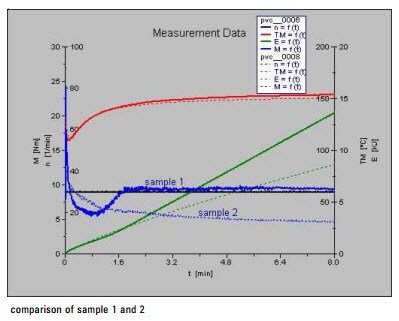 PVC blends are complex mixtures of PVC particles, fillers, lubricants, stabilizers and plasticizers created to provide unique properties to a wide range of end products. Hundreds of different kinds of plasticizers can be added to PVC blends to soften the product, the most common of which are phthalates and adipates.
PVC blends are complex mixtures of PVC particles, fillers, lubricants, stabilizers and plasticizers created to provide unique properties to a wide range of end products. Hundreds of different kinds of plasticizers can be added to PVC blends to soften the product, the most common of which are phthalates and adipates.
The website PVC.org offers the following explanation of the plasticizing process:
PVC is basically rigid at normal temperature. This is due to the short distances between the molecules since there are strong pulling forces between them (intermolecular forces). When heated, the energies of molecular motions become greater than the intermolecular forces, which widen molecular distances, resulting in softening of the resin. When plasticizers are added to PVC at this stage, the plasticiser molecules make their way between the PVC molecules and prevent the PVC polymer molecules from coming closer with each other. Consequently the polymer molecules are kept apart even at normal temperature and softness is maintained.
The type and amount of plasticizer used have a major influence on the melt and processing behavior of the product. PVC dry blends often have the tendency to exhibit greatly differing melt and degradation characteristics after undergoing comparatively small alterations in the recipe. This can lead to variety of problems during processing such as reduced impact strength or the coloring or degradation of the extrudate. Quality control can be achieved with a mixer test using a rheometer system, which offers a quick method to characterize the influence of plasticizers on the plasticization and flow process of PVC dry blends.
The application note, Evaluating the Plasticization Process of Different Soft-PVC Samples describes the results of a study in which four different soft PVC recipes were measured, compared and evaluated using a torque rheometer. The type and amount of plasticizer was varied; the corresponding torque curves helped to differentiate the formulas.
Sample — Amount of plasticizer
1 — 43 phr DOP
2 — 75 phr DOP
3 — 51 phr DOP
4 — 20 phr DOP, 30 phr polymer plasticizer
Sample one showed a typical behavior of PVC dry blends in a mixer. After the initial filling peak, the torque curve dropped to a minimum value. Due to friction and material heating, the torque value rose again, and PVC fusion took place. After some time an equilibrium between shear heating and constant mixer temperature was reached, which resulted in a stable torque curve.
The resulting minimum value of the torque can be used as a relative value of the PVC melt viscosity. The resulting torque curve of measuring sample two is determined by the high amount of plasticizer. Although both samples contain the same amount of filler, the viscosity of sample two is much lower than for sample one.
Sample four, which contains two different plasticizers in the dry blend mixture, gives a completely different torque curve in comparison to sample three. This mixture of plasticizers results in a higher melt viscosity. The polymeric plasticizer cannot replace the phthalate based plasticizer.
By using the statistic view in a mixer project, the user can get an overview of different measurements. It is easy to evaluate the reproducibility of samples by calculating mean values and standard deviation of defined curve points.
Download the application note to view sample comparison diagrams, detailed data evaluation, and valuable hints for substituting PVC blend ingredients.
In our next post, we’ll present an overview of an investigation into how changes in testing conditions can influence measuring results.




Very quickly this web site will be famous amid all blog users,
due to it’s nice articles or reviews
Thank you.